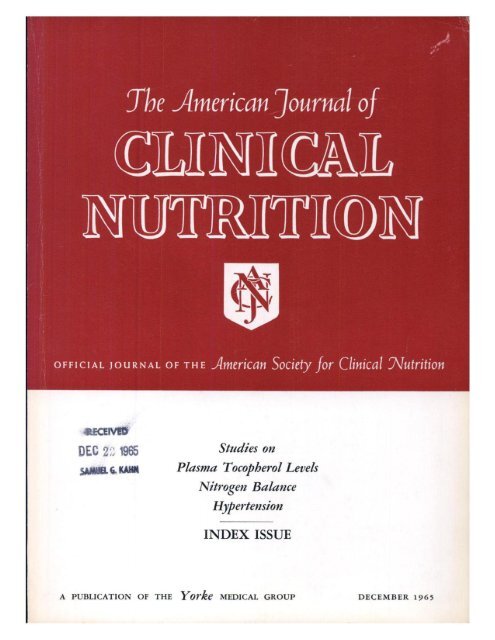Proteomic analysis identifies novel biological pathways that may link dietary quality to type 2 diabetes risk: evidence from African American and Asian cohorts
IF 6.5
1区 医学
Q1 NUTRITION & DIETETICS
引用次数: 0
Abstract
Background
Diet affects the development of chronic diseases such as type 2 diabetes, but the underlying biological mechanisms are only partly understood.
Objectives
This study aimed to identify proteomic markers of the Alternative Healthy Eating Index (AHEI) and the Dietary Approaches to Stop Hypertension (DASH) diet and their association with type 2 diabetes risk.
Methods
We examined the associations between the AHEI and DASH diet quality scores and 1317 plasma proteins in African American participants of the Jackson Heart Study (JHS, n = 1878). These findings were validated in a Singapore Multi-Ethnic Cohort (n = 2395) and examined in relation to type 2 diabetes incidence (n = 539 cases). We adjusted for multiple testing by using false discovery rate–adjusted q values.
Results
We identified 13 proteins consistently associated with the AHEI or DASH scores with the strongest associations for the AHEI score and epidermal growth factor receptor (β:0.089; SE: 0.017; q < 0.001) and for the DASH score and tissue factor (β: −0.114; SE: 0.022; q < 0.001). Most of these proteins were related to inflammation, thrombosis, adipogenesis, and glucose metabolism. Concentrations of myeloperoxidase, epidermal growth factor receptor, hepatocyte growth factor receptor, coagulation factor Xa, contactin 4, kynureninase, neurogenic locus notch homolog protein 1, and vesicular integral-membrane protein VIP36 were associated with the risk of type 2 diabetes in the Asian cohort. The diabetes odds ratio for a 2-fold higher protein abundance concentration ranged from 0.03 (95% CI: 0.01, 0.08) for neurogenic locus notch homolog protein 1 to 3.04 (95% CI: 2.13, 4.33) for kynureninase. Furthermore, genetic markers for myeloperoxidase and hepatocyte growth factor receptor were significantly associated with diabetes risk.
Conclusions
Our study across geographically and ethnically diverse populations identified robust protein biomarkers for healthy dietary patterns. Furthermore, our findings suggest novel biological mechanisms linking dietary patterns with type 2 diabetes development.
蛋白质组分析确定了可能将膳食质量与 2 型糖尿病风险联系起来的新型生物通路:来自非裔美国人和亚洲人队列的证据。
背景:饮食会影响慢性疾病(如 2 型糖尿病)的发展,但人们对其潜在的生物学机制仅有部分了解:本研究旨在确定替代健康饮食指数(AHEI)和高血压饮食疗法(DASH)的蛋白质组标记及其与 2 型糖尿病风险的关系:我们研究了杰克逊心脏研究(JHS,N = 1,878)中非裔美国人的 AHEI 和 DASH 饮食质量评分与 1317 种血浆蛋白之间的关系。这些发现在新加坡多种族队列(N = 2,395)中得到验证,并与 2 型糖尿病发病率(N = 539 例)相关联。我们使用假发现率调整q值对多重检验进行了调整:结果:我们发现 13 种蛋白质与 AHEI 或 DASH 评分一致,其中 AHEI 评分与表皮生长因子受体的关联性最强(β = 0.089,SE = 0.017 q 值):我们的研究在不同地域和种族的人群中发现了健康饮食模式的可靠蛋白质生物标志物。此外,我们的研究结果还提出了将膳食模式与 2 型糖尿病发展联系起来的新生物机制。
本文章由计算机程序翻译,如有差异,请以英文原文为准。
求助全文
约1分钟内获得全文
求助全文
来源期刊
CiteScore
12.40
自引率
4.20%
发文量
332
审稿时长
38 days
期刊介绍:
American Journal of Clinical Nutrition is recognized as the most highly rated peer-reviewed, primary research journal in nutrition and dietetics.It focuses on publishing the latest research on various topics in nutrition, including but not limited to obesity, vitamins and minerals, nutrition and disease, and energy metabolism.
Purpose:
The purpose of AJCN is to:
Publish original research studies relevant to human and clinical nutrition.
Consider well-controlled clinical studies describing scientific mechanisms, efficacy, and safety of dietary interventions in the context of disease prevention or health benefits.
Encourage public health and epidemiologic studies relevant to human nutrition.
Promote innovative investigations of nutritional questions employing epigenetic, genomic, proteomic, and metabolomic approaches.
Include solicited editorials, book reviews, solicited or unsolicited review articles, invited controversy position papers, and letters to the Editor related to prior AJCN articles.
Peer Review Process:
All submitted material with scientific content undergoes peer review by the Editors or their designees before acceptance for publication.

 求助内容:
求助内容: 应助结果提醒方式:
应助结果提醒方式:


